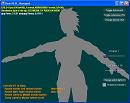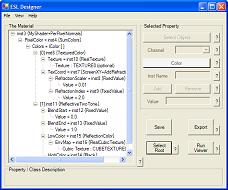|
REQUIRES: .Net 1.1, DirectX 9.0c, and "DirectX
for Managed Code". If FxViewer crashes when you try to open it, it
probably means you don't have "DirectX for Managed Code". I've prepared a
small installer for it, just un-zip and run dxsetup.exe, assuming you
already have .Net 1.1 and DirectX 9.0c
This download contains:
ESL_Designer - An easy-to-use visual graph editor which uses the classes
defined in an ESL file to generate a valid material and then exports it as an
Fx shader (i.e. includes the ESL compiler). Most of the examples from the
examples page are also included and can be loaded up and edited in the
designer.
FxViewer - An example DirectX application which reads the Fx shader outputted by
ESL_Designer and renders an object with that shader. It is an only very
slightly modified DirectX SDK sample, intended to show that ESL can be used
'under-the-hood' very easily.
Also includes: ESL.doc, System.esl and
MyShader.esl
PLEASE feel free to modify the classes in MyShader.esl by adding new ones or
modifying the ones in there. Any changes you make to this file will show up in
the designer and command line compiler. The internal compiler includes pretty
good syntax and compiler errors (with name, line and column) and so you
shouldn't have a hard time writing new code.
NOTE: This package does contain some of the example media from the DirectX SDK.
Because this is not a publicly exposed webpage yet, I think that is okay for
now.
|



